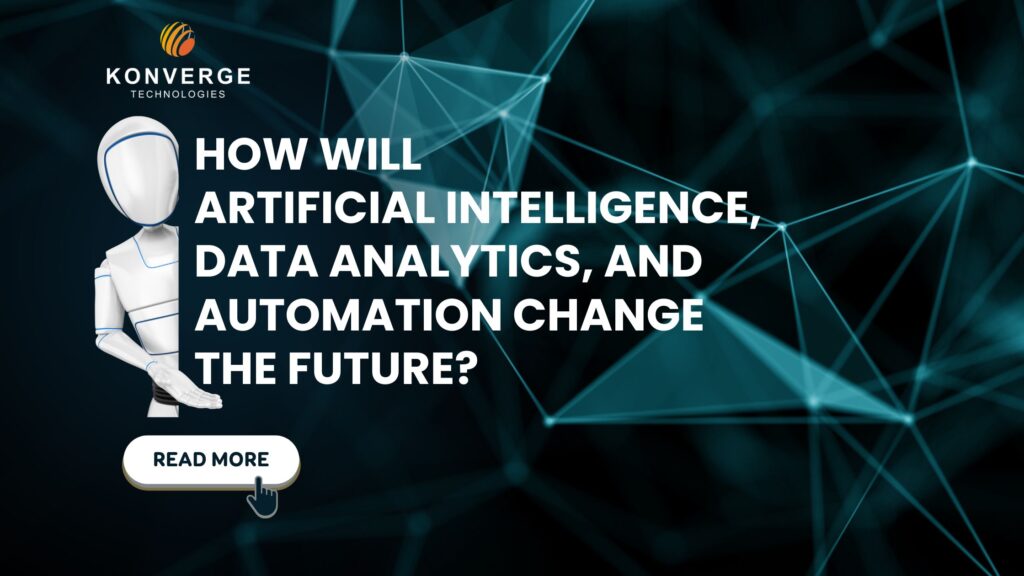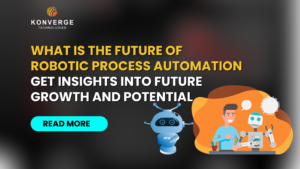
How will artificial intelligence, data analytics, and automation change the future?

Introduction:
A new age of business decision-making is being ushered in by automation, data analytics, and artificial intelligence (AI), which is changing our understanding and use of massive amounts of information. Combining AI techniques with strategic development and predictive analytics is revolutionizing data extraction and manipulation and improving our capacity for prompt, well-informed decision-making.
The Evolution of Artificial Intelligence
As we explore the evolution of artificial intelligence (AI), it’s crucial to recognize the pivotal developments and their transformative impacts across various sectors. Here, we delve into the milestones that have shaped AI’s journey:
- Foundational Advances:
- 1940s–1950s: The concept of AI germinated with the invention of the first programmable digital computer, laying the groundwork for future AI research.
- 1956: The term “artificial intelligence” was coined at the Dartmouth Conference, marking the official birth of AI as a field.
- Golden Years and AI Winters:
- 1956–1974: This period witnessed the creation of ELIZA, the first chatbot, and significant advancements in computer languages, symbolizing the golden years of AI.
- 1974–1987: Characterized by fluctuating interest and funding, these years saw the first and second AI winters, highlighting the challenges in AI development.
- Resurgence and the Modern Era:
- 1987-Present: The resurgence of AI was fueled by the development of expert systems and deep learning technologies. The introduction of AI into everyday life through virtual assistants and the focus on artificial general intelligence illustrates the current stage of AI development.
AI has changed the healthcare, financial, and customer service industries by progressing from simple programmed tasks to sophisticated learning and decision-making skills during these critical times. This development emphasizes how crucial it is to keep learning and adapting in the rapidly evolving fields of artificial intelligence and technology.
The Revolutionary Impact of Data Analytics and Automation
Unquestionably, the revolutionary effects of automation and data analytics are altering industries and the nature of employment in the age of technological transformation. The amount of data being created globally is predicted to increase dramatically from 64 zettabytes in 2020 to 180 zettabytes by 2025, making data analytics automation a crucial component of this process. This automation greatly improves decision-making procedures and operational efficiencies across sectors in addition to streamlining the detection of risks and vulnerabilities.
- Efficiency and Productivity:
- Automation of routine and repetitive tasks leads to substantial time savings and minimizes error margins.
- Predictive analytics, utilizing AI and machine learning techniques, offers foresight into future trends, enabling proactive rather than reactive strategies.
- Challenges and Opportunities:
- While data analytics automation promises cost optimization and reduced bias by drawing from diverse, reliable sources, it also presents challenges such as data security concerns and the potential loss of human judgment.
- The demand for skilled data analysts remains high, emphasizing the importance of accuracy, transparency, and strategic decision-making in automated processes.
Incorporating AI into automation and data analytics not only improves existing systems but also opens up new possibilities and capabilities. Achieving a balance between utilizing automated technology and preserving critical human oversight becomes critical as firms maneuver through this dynamic environment. A future where analytics, automation, and artificial intelligence (AI) are at the center of company strategy and operations may be anticipated by making the appropriate technological investments, upskilling the workforce, and keeping up with developing trends.
Emerging Trends and Predictions for AI and Automation
As we gaze into the future of AI and automation, several emerging trends and predictions stand out, promising to redefine the landscape of technology and its application across various sectors.
- Manufacturing and Analytics:
- Data Analytics Platforms: These platforms are revolutionizing the manufacturing sector by providing insights for decision-making across the production chain, leading to smarter, more efficient future factories.
- Edge Analytics: offers real-time optimizations, ensuring tighter tolerances and reduced resource waste.
- Impact: Significant reduction in decision-making uncertainty, fostering more creative and intuitive choices.
- Healthcare and Ethical Considerations:
- Advancements: AI’s progress in language and image processing is notably enhancing healthcare and brain sciences.
- Challenges: The automation of decisions raises concerns about misinformation, discrimination, and the exacerbation of biases.
- Solutions: Continuous engagement and clear communication between human and automated decision-makers are crucial to minimizing negative impacts.
- Creative and Generative AI:
- Innovations: AI’s ability to generate original content opens new avenues in art, music, and literature, while also raising ethical questions about creativity and ownership.
- Applications: From personalizing user experiences in e-commerce to automating repetitive tasks, AI is set to transform business processes, healthcare, and education, and even tackle climate change through predictive analytics.
These trends underscore the importance of a balanced approach to AI and automation, where technological advancements are harmonized with ethical considerations and human oversight, ensuring that the benefits are equitably distributed across society.
Preparing for the Future: Skills and Strategies
Both individuals and companies need to adapt and get ready for the future as we negotiate the ever-changing world of automation, data analytics, and artificial intelligence. The following techniques and abilities are essential for prospering in a future driven by AI:
Key Skills for the AI Era
- Technical and Analytical Skills: Proficiency in data literacy, advanced data analytics, and coding is paramount. Understanding AI tools and their applications in one’s field can lay the foundation for innovation.
- Soft Skills: Emotional intelligence, strong communication, and adaptability are essential for working alongside machines and in teams.
- Continuous Learning: Embracing lifelong learning, staying informed on AI advancements, and acquiring new skills related to emerging technologies.
Workforce preparation strategies
- AI Integration Strategy: Before adopting AI tools, develop a clear strategy that aligns with your organization’s assignment. Identify key areas where AI can enhance operations and create a powerful governance framework for its use.
- Upskilling and Reskilling: Focus on reskilling employees for roles that AI could automate. Assess professional goals and match them with organizational needs. Upskill existing talent in data and AI to foster a data-driven culture.
- Collaboration with AI: Learn to leverage AI systems to amplify human capabilities. Identify tasks suitable for automation or enhancement by AI to boost productivity.
Adapting to the AI-Powered Future
- Navigating Change: Stay relaxed and proactive in adapting to industry shifts. Cultivate a growth mindset and be open to new opportunities arising from AI integration.
- Ethical Considerations: Understand the implications of AI on your industry, including potential job displacement and ethical dilemmas. Establish governance protocols to ensure ethical AI use.
By focusing on these skills and strategies, we can position ourselves and our organizations for success in an AI-dominated future, ensuring that we not only adapt to changes but also lead in innovation and ethical AI implementation.
We have turned back the clock to the beginning of man-made reasoning (computer-based intelligence), analyzed its transformative defining moments, and grasped how it works together with robotization and information examination. As was referenced, these innovative advancements are reshaping numerous businesses, further developing navigation, and totally changing all types of proficiency. It is difficult to misjudge the amount of computer-based intelligence, information examination, and robotization that will shape the upcoming working conditions, which will see a push toward more creative, effective, and prescient strategies in both the individual and expert circles.
We are at the front line of a mechanical transformation, so it is important that we adjust fundamental abilities and techniques to be prepared for a computer-based intelligence-controlled future. Through focusing on the improvement of both hard and delicate abilities, as well as moral worries and continuous instruction, the two individuals and associations are encouraged to adopt a proactive strategy to explore this powerful climate. Given the colossal impacts of robotization and man-made brainpower, a reasonable way to deal with innovation reconciliation is important to guarantee that, as we proceed, we do as such with insight, consideration, and a relentless devotion to improvement.
FAQs
Artificial intelligence and automation are expected to significantly impact the future of work by potentially displacing jobs that consist of routine and repetitive tasks. Vulnerable sectors include manufacturing, data entry, and customer service, where automation could take over many of the tasks currently performed by humans.
Artificial intelligence is set to revolutionize the education sector. With AI’s assistance, educational content and training will be highly customized to meet the specific needs of individual students. AI will also facilitate the identification of the most effective educational strategies based on each student’s unique learning style. By 2028, we anticipate that the education system will undergo such profound changes that it may be almost unrecognizable compared to today’s standards.
AI will bring about a paradigm shift in data analytics by processing and analyzing large datasets in real time. This capability allows for the application of AI algorithms that can identify patterns and insights, such as predictive analytics and anomaly detection, which human analysts could easily miss. Consequently, companies will be able to make more proactive and informed decisions based on data.
Artificial intelligence has become an essential asset for enhancing data science, especially when dealing with substantial datasets. AI-driven solutions, like anomaly detection and the automation of data processing, enable human analysts to manage and derive insights from much larger quantities of data than would be possible without AI assistance.
Recent Posts


What is the future of Robotic Process Automation get Insights into Future Growth and Potential


